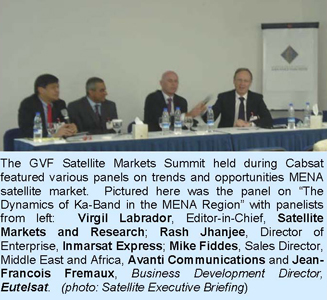Satellite 2012 and Cabsat 2012 Highlight Continued Growth in the Global Satellite Market
by Virgil Labrador, Editor-in-Chief
Dubai, UAE and Washington, D.C., April 1, 2012--The satellite industry will continues to grow in the coming years albeit at a more modest pace. This was the consensus among senior satellite industry executives speaking at the Satellite 2012 Conference and Exhibition in Washington, D.C. and Cabsat/Satellite MENA 2012 in Dubai, UAE held last month. There are some concerns with the developing economic crisis in Europe, where three of the four major satellite operators are based, but the mood is decidedly bullish.
After having weathered the Great Recession of 2007-09, the satellite industry is poised for more growth as increasing bandwidth requirements from broadband, HD and other new applications are driving demand for satellite transponders and services. “We have seen how resilient the satellite industry is in difficult times,” said Romain Bausch, CEO of SES, at the opening general session at Satellite 2012 modestly dubbed “The Big Four: At the Center of the Satellite Universe.”
 With the mature markets of North America and Europe projected to remain flat in the next few years, satellite operators are focusing their efforts in the emerging markets of the Middle East, Africa and Latin America. This was evident at the Cabsat show in Dubai held just two weeks before Satellite 2012. The Middle East/ North Africa (MENA) market grew by 20% in just the last year and this was clearly demonstrated by the activity at the conference and exhibits at Cabsat.
With the mature markets of North America and Europe projected to remain flat in the next few years, satellite operators are focusing their efforts in the emerging markets of the Middle East, Africa and Latin America. This was evident at the Cabsat show in Dubai held just two weeks before Satellite 2012. The Middle East/ North Africa (MENA) market grew by 20% in just the last year and this was clearly demonstrated by the activity at the conference and exhibits at Cabsat.
“The Middle East broadcasting, digital media and satellite industries are considered within the most lucrative in the world. CABSAT is the ideal platform for industry professionals worldwide to come together and explore new avenues in this growing market,” said Helal Saeed Almarri, CEO, Dubai World Trade Center, organizers of Cabsat.
The most recent edition of the Cabsat exhibition held in Dubai from February 28-March 1 was its largest to date with over 800 exhibitors from 55 countries including 14 national pavilions. What is even more amazing is that the show added 173 new exhibitors just in the last year—an almost 20 percent increase from 2011 (which coincidentally was the same growth rate for the MENA region last year).
The MENA region is leading the field in Ka-Band satellites launched, with more coming in the near term. Ka-Band satellites provide more bandwidth and are ideal for broadband applications. NSR Senior Analyst Claude Rousseau, Senior Analyst for NSR, who spoke at a panel at the GVF Satellite Markets Summit during Cabsat, is estimating if the current rate of satellite launches continue, oversupply can happen by 2015 or 2016. Oversupply can lead to a price war which will drive down prices of transponders. The recent number of launches has already seen transponder prices dropping incrementally in the region and that trend will likely continue as more High Throughput Satellites (HTS) come on board.
Apart from the looming debt crisis in Europe, several executives are concerned about the slowdown in investments in new satellites. The number of commercial GEO satellites ordered dropped from 28 in 2010 to only 17 in 2011. Despite the drop in new satellite orders, there is nagging fear that the recent rash of new satellites deployed in the merging markets of the Middle East, Africa and Latin America can lead to an transponder oversupply in those regions.
The reported success of recently-launched high throughput Ka-Band satellites such as Viasat-1 in North America, KA-SAT in Europe and Yahsat in the Middle East and Africa has spurred on other Ka-Band initiatives from other satellite operators such as Arabsat, Hispasat and startup operator Newsat, among others. SES is particularly bullish about its investment in the O3b all-Ka-Band satellite constellation which is scheduled to launch its first eight satellites in 2013.
The Ka-Band satellites, which have up to 10 times more capacity than conventional C– and Ku-Band satellites, are counting on the growing demands for broadband access in many areas of the world underserved by terrestrial media.
One of the biggest buzz at Satellite 2012 was made by Boeing’s announcement of its new electric-powered satellite platform 702SP series which promises to cut manufacturing and launch costs by a substantial factor. The electric-powered satellites will be smaller and will weigh less, making it less expensive to launch.
The first customers of the 702SP series were Hong Kong-based Asia Broadcast Satellite and Mexican satellite operator Satmex, who teamed up to get a joint procurement contract for four satellites (two each for ABS and Satmex). The joint procurement is seen as a way in which smaller satellite operators can join forces to take advantage of the discounts and benefits that larger satellite operators get from manufacturers and launch service providers.
The downside to the new electric-powered 702SP satellite bus is that it will require four-six months to transfer a satellite from the geo transfer orbit to geosynchronous orbit. Some analyst are viewing the more affordable electric-powered 720SP platform as a game changer which will make it easier for smaller satellite operators to procure new satellites and replace old ones.
Partnerships or what some view as “Coopertition” seems to be getting more traction in the industry as competition heats up among major players. At the CEO roundtable at Satellite 2012, ABS CEO Tom Choi said that smaller satellite companies who are looking to compete in the crowded satellite market should “partner with the larger companies or get lost in the crowd.”
“In the past only the largest satellite operators were allowed to enjoy the benefits of bulk satellite buys. Now, through partnerships, regional firms can split the cost with a larger entity,” Choi added.
The one bad news for the satellite operators is the government budget cuts worldwide on military spending. The decline in military spending will impact satellite companies which derives from 10-20 percent of its revenues from the government and military markets. The bright side is that Unmanned Aerial Vehicles (UAV) and other security applications are opening up new markets for satellite services in the government and military sectors.
Broadcast services continues to be the major source of revenues for satellite operators. In the Broadcasters Roundtable Panel at Satellite 2012, speakers affirmed that satellite will continue to play an important role in their distribution stra-tegy. John McCoskey, CTO of PBS said that they need to reach out to many rural stations that can only be reached by
satellite. David Couret, Technical Solutions Director, AudioVisual Exterior of France said that “for some regions like Africa, satellite is the only viable way to reach their viewers.”
The broadcasters acknowledge, however, that the distribution paradigm has changed. McCoskey said that in just the last five years their distribution platforms has increased to twenty different formats that they need to reach out to. Vince Roberts, EVP and CTO of Disney pointed out that over 30 TBs of data are moved around the world daily in different formats and languages and the challenge is to digitize them and make them scalable.
After attending both Satellite 2012 and Cabsat last month, one can’t help but be optimistic for the prospects in the near term for the satellite industry.
--------------------------------------------
 Virgil Labrador is the Editor-in-Chief of Satellite Market and Research based in Los Angeles, California. He is the author of two books on the satellite industry and has been covering the industry for various publications since 1998. He can be reached at virgil@satellitemarkets.com
Virgil Labrador is the Editor-in-Chief of Satellite Market and Research based in Los Angeles, California. He is the author of two books on the satellite industry and has been covering the industry for various publications since 1998. He can be reached at virgil@satellitemarkets.com





